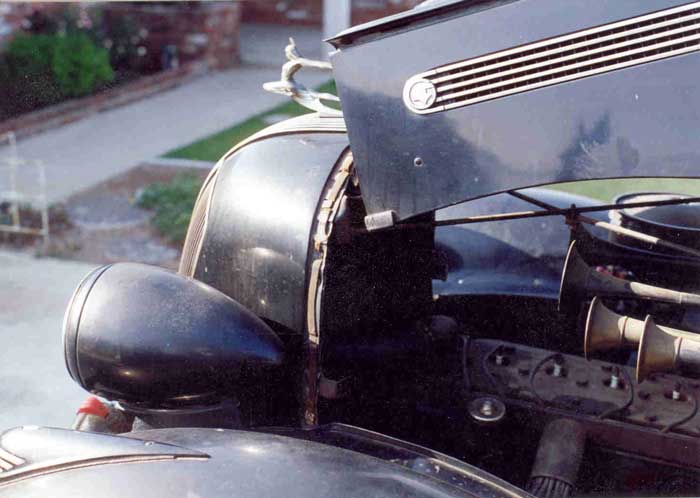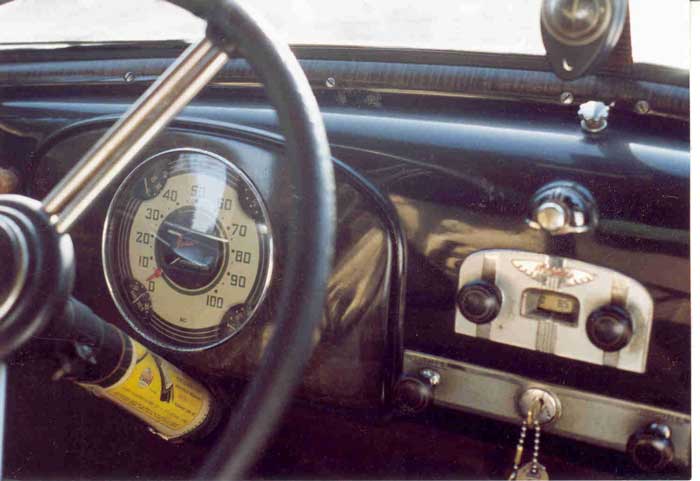
1935 Pontiac General Facts by Rick Bodziak
GM was by 1935 starting to standardize the use of various bodies throughout their car lines. Most of the bodies were now supplied by Fisher Body. The 1935 and 1936 Pontiac, Oldsmobile, and LaSalle used the exact same body stampings, from the cowl back. The differences between them were what distinguished them from each other. Namely the dash inset, fenders, hoods, bumpers, running boards, etc. The convertibles used the very same top and vent window assemblies. It is possible the vent window and top assemblies used in the Buick and Chevy DeLuxe lines were the same also. I have not been able to verify this.
The 1936 Chevy DeLuxe was not the same body as reported elsewhere. Various pieces of sheet metal such as the lower front cowl, rocker panel, and floor boards were close enough to use in a pinch, but not an exact match. All 1935 and 1936 Pontiac, Master Chevy, Oldsmobile, and LaSalle front and rear fenders can be mounted on any 1935 Pontiac. The only problem is they are visually very different. 1935 Pontiac convertibles used an oval rear window frame in the convertible top, not the common squared-off Chevy replacement that is available today. The difference between the Pontiac six and DeLuxe eight cars is as follows: The DeLuxe eight had a longer chassis. The body used was exactly the same body used on the six models. The extra length of the DeLuxe eight was taken up in longer running boards and the hood assembly. The front fenders were the same in both the eight and six lines. The fenders were mounted farther forward on the cowl on the DeLuxe eight cars.
When these cars were built they proceeded down the assembly line in a random order. That is to say there could be a 2 door Coupe then a 4 door Sedan followed by another 4 door Sedan. It was based on perceived demand by the public and dealers. At the start of the model year the majority of the cars built were probably 2 door and 4 door Sedans as these models were the most in demand. A few Coupes and a very few Convertibles were built probably by dealer order only.
The bodies were built ahead of time anticipating demand . They were stored until needed by Fisher Body in a second floor warehouse above the assembly lines. As orders were received the various bodies were removed from stock and moved to a drop zone, then lowered thru the floor to the assembly line below. This is why you may find a car with a high chassis number but a body with a very low number. As the bodies were pulled from stock in random order. The body could have been built weeks before and just not used, or the demand was low as in the case of the convertibles.
The Convertibles, as far as I have been able to find out, were built in batches of 2 to 10 bodies at a time. They were painted the same color and had the same trim. Body plates were stamped at this time with color, trim, body number, etc. They were then put in storage until needed. Usually they were built to order only as demand for a Convertible of any kind was very low by 1935. The reason for the very high number of 1935 and 1936 GM cars that are painted green is that GM put on a traveling auto show that toured around the country at that time and most of the cars were painted bright green. So when people placed orders for a new car they chose bright green naturally! Al least 50% of the surviving 1935 and 1936 Pontiac’s that I have seen are painted that bright green. Both of mine were originally bright green too!
GM was by 1935 starting to standardize the use of various bodies throughout their car lines. Most of the bodies were now supplied by Fisher Body. The 1935 and 1936 Pontiac, Oldsmobile, and LaSalle used the exact same body stampings, from the cowl back. The differences between them were what distinguished them from each other. Namely the dash inset, fenders, hoods, bumpers, running boards, etc. The convertibles used the very same top and vent window assemblies. It is possible the vent window and top assemblies used in the Buick and Chevy DeLuxe lines were the same also. I have not been able to verify this.
The 1936 Chevy DeLuxe was not the same body as reported elsewhere. Various pieces of sheet metal such as the lower front cowl, rocker panel, and floor boards were close enough to use in a pinch, but not an exact match. All 1935 and 1936 Pontiac, Master Chevy, Oldsmobile, and LaSalle front and rear fenders can be mounted on any 1935 Pontiac. The only problem is they are visually very different. 1935 Pontiac convertibles used an oval rear window frame in the convertible top, not the common squared-off Chevy replacement that is available today. The difference between the Pontiac six and DeLuxe eight cars is as follows: The DeLuxe eight had a longer chassis. The body used was exactly the same body used on the six models. The extra length of the DeLuxe eight was taken up in longer running boards and the hood assembly. The front fenders were the same in both the eight and six lines. The fenders were mounted farther forward on the cowl on the DeLuxe eight cars.
When these cars were built they proceeded down the assembly line in a random order. That is to say there could be a 2 door Coupe then a 4 door Sedan followed by another 4 door Sedan. It was based on perceived demand by the public and dealers. At the start of the model year the majority of the cars built were probably 2 door and 4 door Sedans as these models were the most in demand. A few Coupes and a very few Convertibles were built probably by dealer order only.
The bodies were built ahead of time anticipating demand . They were stored until needed by Fisher Body in a second floor warehouse above the assembly lines. As orders were received the various bodies were removed from stock and moved to a drop zone, then lowered thru the floor to the assembly line below. This is why you may find a car with a high chassis number but a body with a very low number. As the bodies were pulled from stock in random order. The body could have been built weeks before and just not used, or the demand was low as in the case of the convertibles.
The Convertibles, as far as I have been able to find out, were built in batches of 2 to 10 bodies at a time. They were painted the same color and had the same trim. Body plates were stamped at this time with color, trim, body number, etc. They were then put in storage until needed. Usually they were built to order only as demand for a Convertible of any kind was very low by 1935. The reason for the very high number of 1935 and 1936 GM cars that are painted green is that GM put on a traveling auto show that toured around the country at that time and most of the cars were painted bright green. So when people placed orders for a new car they chose bright green naturally! Al least 50% of the surviving 1935 and 1936 Pontiac’s that I have seen are painted that bright green. Both of mine were originally bright green too!
Color schemes by paint code on data plate
Code |
Body |
Moulding |
Stripe |
05 |
Black |
Black |
Tacoma Cream |
06 |
Stygian Blue |
Stygian Blue |
Tacoma Cream |
07 |
Regent Maroon |
Black |
Gold Bronze |
08 |
Sagebrush Green Dark |
Sagebrush Green Dark |
Tacoma Cream |
09 |
Gettysburg Blue |
Gettysburg Blue |
Tacoma Cream |
10 |
Rivermist Gray |
Black |
Ski Green |
11 |
Eagle Brown |
Eagle Brown |
Tacoma Cream |
12 |
Chardogne Cream |
Chardogne Cream |
Black |
13 |
Milan Maroon |
Black |
Tacoma Cream |
Magazine Ad Links: American Decides Low Priced Six Measure this Six Simply can't do Better
Thanks to Reid Williamson for the '35 photos and Rick Bodziak for the Color Scheme information.
The Original Silver Streak Pontiac By Pete Woodruff
The Most Beautiful Thing on Wheels was how Pontiac billed the new 1935 models. General Motors’ Fisher Body scooped the industry with the new “Turret Top” all-steel roofs. Prior to ’35, cars typically had a fabric panel of some sort to seal the roof of enclosed cars; a method that was certain to fail in time. All it took was a stamping press big enough to punch out an entire roof panel and history was made.
Hydraulic brakes were another great feature that debuted for ’35; the ad copy listed these second only to the “Turret Top” as the big features for the new models. Fisher bodies also benefited from the vent windows that allowed for “No Draft” ventilation; if you’ve ever driven a late-model car at highway speeds with the windows down, you can really appreciate how effective the old system was. To be fair, without air conditioning you had to have open windows; but you did pay a penalty in fuel economy through increased wind resistance, which is why new cars are so terrible with the windows open, they aren’t designed to be open at speed.
Frank Hershey was the stylist responsible for the new Silver Streak look; by his own admission, he copied the look from the ’34 Bentley. Frank went on to design the ’55 Thunderbird for Ford and actually attended the ’90 POCI convention in Kansas City. I was fortunate to be introduced to him by Kerry Klotzman and we had a great conversation. Kerry was asking about his ’35 opera coupe; a very beautiful model that he has brought each year to the Flathead Reunion.
The Deluxe Six and the Eight both had Knee Action front suspension carried over from ‘34, while the standard Six received a solid axle. The DuBonnet system completely enclosed the coil springs in oil but proved to be leak-prone; it was quickly replaced with the familiar SLA (short/long arm) style of suspension that Pontiac used until they switched to MacPherson struts in the late 80’s.
The Eight still displaced 223 cubic inches as originally produced in 1933; but was improved with silver alloy rod bearing inserts and also an automatic choke Carter carburetor. (An Oldsmobile innovation dating from 1932.) The “suicide” front doors were only used in 1935; the surest way to know you’re looking at a 1935 model.
The Most Beautiful Thing on Wheels was how Pontiac billed the new 1935 models. General Motors’ Fisher Body scooped the industry with the new “Turret Top” all-steel roofs. Prior to ’35, cars typically had a fabric panel of some sort to seal the roof of enclosed cars; a method that was certain to fail in time. All it took was a stamping press big enough to punch out an entire roof panel and history was made.
Hydraulic brakes were another great feature that debuted for ’35; the ad copy listed these second only to the “Turret Top” as the big features for the new models. Fisher bodies also benefited from the vent windows that allowed for “No Draft” ventilation; if you’ve ever driven a late-model car at highway speeds with the windows down, you can really appreciate how effective the old system was. To be fair, without air conditioning you had to have open windows; but you did pay a penalty in fuel economy through increased wind resistance, which is why new cars are so terrible with the windows open, they aren’t designed to be open at speed.
Frank Hershey was the stylist responsible for the new Silver Streak look; by his own admission, he copied the look from the ’34 Bentley. Frank went on to design the ’55 Thunderbird for Ford and actually attended the ’90 POCI convention in Kansas City. I was fortunate to be introduced to him by Kerry Klotzman and we had a great conversation. Kerry was asking about his ’35 opera coupe; a very beautiful model that he has brought each year to the Flathead Reunion.
The Deluxe Six and the Eight both had Knee Action front suspension carried over from ‘34, while the standard Six received a solid axle. The DuBonnet system completely enclosed the coil springs in oil but proved to be leak-prone; it was quickly replaced with the familiar SLA (short/long arm) style of suspension that Pontiac used until they switched to MacPherson struts in the late 80’s.
The Eight still displaced 223 cubic inches as originally produced in 1933; but was improved with silver alloy rod bearing inserts and also an automatic choke Carter carburetor. (An Oldsmobile innovation dating from 1932.) The “suicide” front doors were only used in 1935; the surest way to know you’re looking at a 1935 model.


